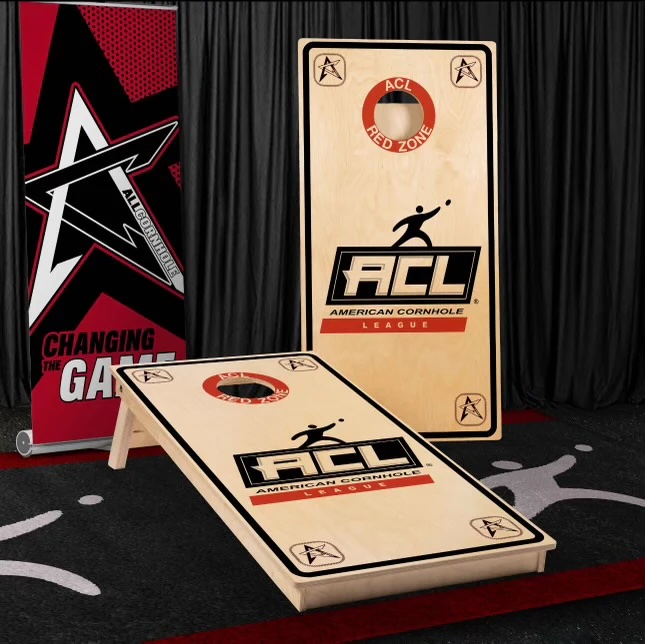Cornhole Boards 101: Materials, Builds, and What Really Matters

If you’ve shopped for cornhole boards lately, you’ve seen everything from $70 backyard sets to $500+ pro rigs—all claiming to be “regulation.” This guide breaks down the real differences: materials, size, structural reinforcement, finishes, common add-ons, and what you get for the price at each level.
Regulation basics (so you know what “right” looks like)
Official boards are 24" x 48" with a 6" hole centered 9" from the top and 12" from each side. The back sits about 12" off the ground; the front is roughly 3–4". A smooth, consistent surface is key. Anything that deviates from these dimensions or plays wildly faster/slower than standard will feel “off,” especially if you’re practicing for league nights.
Materials: the biggest driver of feel and longevity
Entry-level wood (MDF/soft plywood). Many budget sets use MDF or thin pine ply for the deck and softwood frames. They’re light and cheap, but they dent, swell with moisture, and warp. Bounce is common because the deck flexes and frames aren’t braced well. Great for a casual backyard toss; not great for building consistent touch.
Solid plywood / cabinet-grade (the sweet spot). The step up is 1/2"–3/4" cabinet-grade plywood, often birch. Better sets use 3/4" Baltic birch—dense, void-free, and very stable. This is the standard for tournament-quality decks because it all but eliminates bounce and warping and gives a predictable “thud” and slide.
Composite & HDPE “all-weather.” Plastic or composite decks won’t absorb water and can be hosed off—ideal for patios and beach houses. They’re durable, but can sound hollow and sometimes play bouncier unless well-braced. Surface speed varies by brand; some are slicker out of the box.
Frames: softwood vs hardwood vs aluminum. Budget frames are usually pine with simple pocket screws. Premium frames use hardwood or thicker birch rails with glued joinery and center braces. A few makers offer aluminum frames (rigid, weatherproof, lighter to carry), often paired with wood or composite decks.
Sizes: regulation, tailgate, and junior
Regulation (24" x 48"). If you play in leagues or watch pros, buy these. The distance, arc, and landing speed you learn will actually transfer to competitive play.
Tailgate (24" x 36" or 2’ x 3’). More portable and cheaper, but your muscle memory for airmails and slides won’t map perfectly back to regulation boards.
Junior / travel. Anything smaller (e.g., ~18" x 36" or even 12" x 24") is great for kids or tight spaces. Treat them as fun games, not practice tools.
Structural reinforcement: bounce, warping, and noise
A deck that’s too thin or poorly braced will “trampoline,” making blocks unreliable and roll bags unpredictable. Look for:
- Center cross-brace under the deck to kill bounce.
- Thicker rails and tight joinery (glue + screws).
- Flush deck with no screw heads on top.
- Rubber feet or anti-skid pads so the board doesn’t walk forward after a hard push.
If you like a quieter board for indoor play, some builders add sound-dampening pads or foam along the frame. The goal is a solid “thud,” not a hollow “boing.”
Surface finishes: speed, durability, and graphics
Raw wood is too slow and chews bags. Clear polyurethane (multiple coats, sanded between) gives a durable, medium-fast surface and protects against humidity. Printed vinyl wraps deliver custom graphics; the crucial bit is a quality clearcoat over the wrap so bags slide consistently and the graphic doesn’t peel at the hole edge. Many competitive players prefer a smooth, semi-gloss finish—slick enough for slides and pushes, not so glassy that every bag sails off the back.
Edge treatment matters too. Rounded hole and board edges protect bags from premature fraying and keep chips at bay.
Features & add-ons
- Leg systems. Fold-out legs are standard; premium sets add locking hardware, thicker leg stock, and braces for rock-solid stance.
- Handles & conveniences. Cut-in side handles, cup holders, or built-in score trackers make league nights smoother.
- Lights. Ring lights around the hole or under-glow strips help with dusk games; just note that edge lights can change bag visibility/reads slightly.
- Carrying cases. If you’re hauling boards to leagues, a padded case saves dings and keeps finishes looking fresh.
Price tiers: what you actually get
$60–$150 (backyard value). Thin deck, minimal bracing, softwood frames, basic finish. Fun for cookouts; expect some bounce and weather sensitivity.
$150–$300 (serious casual / league starter). Thicker plywood, at least one center brace, better finishes, rounded edges. If you want to improve without breaking the bank, start here.
$300–$500 (tournament-grade). 3/4" Baltic birch decks, stout frames, multiple braces, professional clearcoat over wrap, rubber feet, flush tops, consistent speed. This is where most competitive players land.
$500+ (premium/custom). Dialed tolerances, aluminum frames, advanced coatings, custom art, matching accessories. You’re paying for perfection, aesthetics, and durability.
Picking the right board for how you play
- Backyard & family: all-weather composite or mid-grade plywood with decent bracing. You’ll get durability and better feel than bargain sets without babying them.
- Practice for leagues: regulation size, plywood (ideally Baltic birch), center-braced, quality clearcoat.
- Tournaments or content creators: tournament-grade or premium sets with predictable speed, minimal bounce, and finishes that photograph well.
Quick checklist before you buy
- Regulation dimensions? 24" x 48", 6" hole, proper leg heights.
- Deck thickness & material? Aim for 3/4" Baltic birch for the most consistent play.
- Bracing? Center brace is non-negotiable if you hate bounce.
- Finish? Multiple clear coats, smooth edges, protected graphic if wrapped.
- Feet & stability? Rubber pads and solid leg hardware.
- Use case? If boards live outside, consider composite or be ready to store wood boards indoors.
Pick a build that matches your goals, not just your budget. With the right materials and reinforcement, a good set of boards turns every throw—from soft blocks to sky-high airmails—into exactly the kind of reps that make you better.
